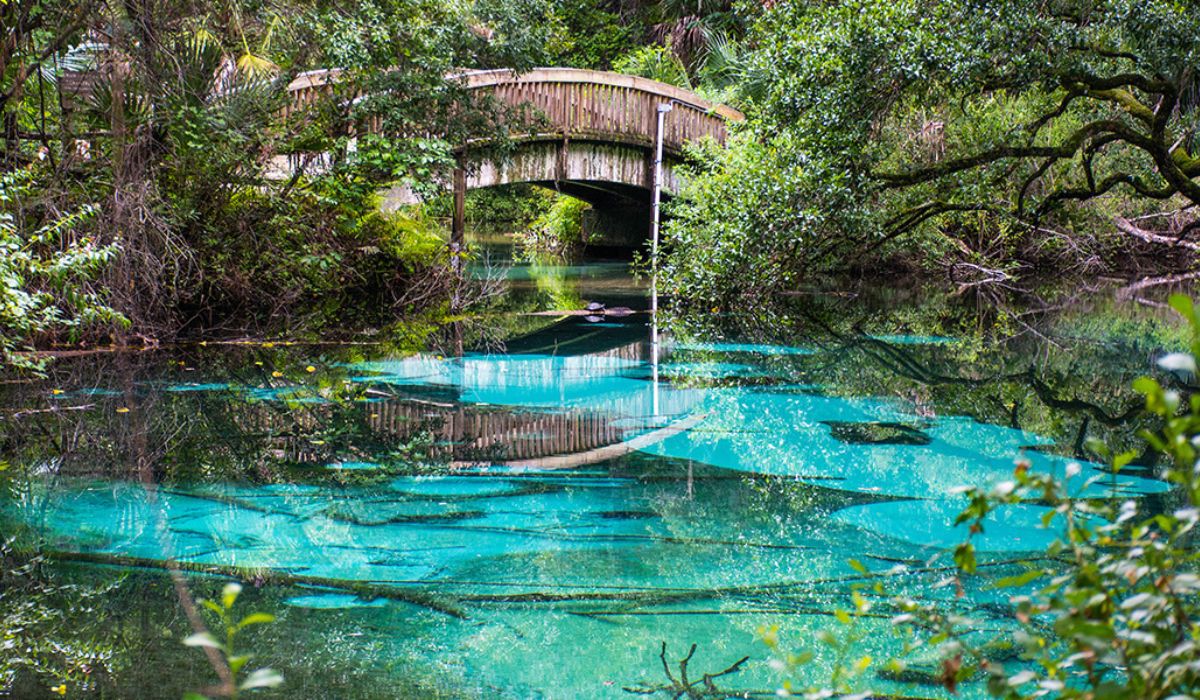Juniper Springs is a beautiful natural sanctuary in Florida’s Ocala National Forest, frequented by ecotourists, adventurers, and city slickers in search of tranquility. Visitors will find peace and beauty in Juniper Springs thanks to its clean waters, abundant flora, and wide variety of fauna.
The History of Juniper Springs
Evidence of early human habitation in the Juniper Springs area extends back thousands of years. Historically, the area was populated by Native American groups including the Timucua and Seminole, who thrived off the land’s rich agricultural potential and untainted water supplies. For hundreds of years, the spring has been both a vital resource and a sacred site.
The Geology of Juniper Springs
When it comes to the volume of water it releases, Juniper Springs is a first-magnitude spring. The Floridan Aquifer is a network of underground limestone caverns that supply the pristine water. Visitors come from all around to see the stunning pool formed by the spring’s water, which is surrounded by verdant greenery.
Flora and Fauna
There is a wide variety of plant and animal life in the habitat that surrounds Juniper Springs. A beautiful scene is painted by the tall longleaf pines, stately oaks, and colorful wildflowers. White-tailed deer, red foxes, river otters, and a wide variety of birds are just some of the wildlife that can be seen by wildlife enthusiasts. The combination of natural components produces an attractive and relaxing atmosphere.
Activities at Juniper Springs
Canoeing and Kayaking
Canoeing or kayaking along Juniper Run is an excellent way to get to know the Juniper Springs area. The 7-mile creek runs through beautiful scenery and abundant foliage, making it possible to spot local fauna. The tranquility of your surroundings will absorb you as you paddle across the clear waters, making this an experience you will never forget.
Swimming and Snorkeling
The water in Juniper Springs stays around 22 degrees Celsius (72 degrees Fahrenheit) year-round, making it perfect for swimming and snorkeling. The crystal-clear water makes it easy to observe the marine life and limestone structures below.
Hiking and Nature Trails
Those who would rather stay on dry land will find a wide range of hiking and nature trails at Juniper Springs. Each trail, whether it’s a short stroll or a strenuous hike, will immerse you in the splendor of nature and lead you to hidden jewels like Fern Hammock Springs or the Millpond Recreation Area.
Camping and Picnicking
Camping is available at Juniper Springs for anyone who would like to make a longer trip out to the bush. There is no better way to experience the outdoors than by sleeping under the stars in a tent while listening to the wildlife all around you. In addition, there are picnic places where you may enjoy a meal while taking in the beautiful surroundings.
Nearby Attractions
Silver Glen Springs
Silver Glen Springs is another close natural attraction. The blue color of the spring, which comes from the sand at its base, is one of its most appealing features. Snorkeling is a great way to see the aquatic life and vegetation in the spring, making it a great addition to your vacation in Juniper Spring.
Alexander Springs
Alexander Springs is a great place to swim and snorkel because of its shallow waters and sandy bottom. It’s a nice spot to take the kids or just chill out with friends.
Ocala National Forest
The Ocala National Forest, one of Florida’s largest, is home to a wide variety of recreational options. This huge wilderness is an outdoor enthusiast’s dream, hosting a wide variety of activities from hiking and biking to birdwatching and equestrian riding.
Conservation and Preservation Efforts
The region around Juniper Spring, including the town itself, is protected by the federal government as part of the Ocala National Forest. Many people are working to protect this ecosystem so that future generations can also appreciate it. To lessen their influence, tourists are urged to practice Leave No Trace ethics.
Tips for a Memorable Visit
- If you want to enjoy Juniper Springs without dealing with crowds, your best bet is to go during the week.
- To save trash and help preserve natural resources, please bring your own refillable water bottles and snacks.
- Keep your distance and never approach or feed wild animals.
- To ensure everyone’s safety and enjoyment, please adhere to the park’s laws and regulations at all times.
Conclusion
At Juniper Springs, you can get away from it all and into the wilds of Florida. This magical haven can provide either the exhilarating adventure or tranquil refuge you seek. There is something for everyone in Juniper Springs, from the interesting geology and rich animals to the many recreational opportunities and local attractions.
FAQs
Can I swim in Juniper Springs all year round?
The water in Juniper Spring is a comfortable 72 degrees Fahrenheit (22 degrees C) all year round, so swimming is possible whenever the mood strikes.
Are there camping facilities available at Juniper Springs?
Campsites are available in Juniper Springs for those who prefer to spend more than a day taking in the area’s spectacular scenery.
What kind of wildlife can I expect to see at Juniper Spring?
White-tailed deer, river otters, and many different kinds of birds are just some of the fauna that make their home in Juniper Spring.
Is snorkeling allowed in Juniper Spring?
Snorkeling is permitted in Juniper Springs, giving visitors with a one-of-a-kind chance to explore the area’s rich marine life and stunning underwater limestone formations.
Are there nearby attractions to visit along with Juniper Springs?
Silver Glen Springs and Alexander Springs are both within driving distance, and they both feature unique natural treasures.











